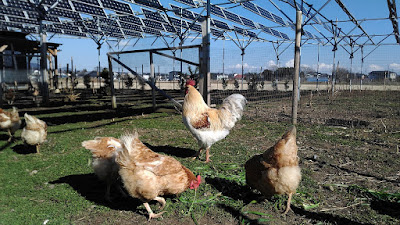2017 is Year of the Rooster, so here's our Justin, completely oblivious to his newfound fame.
 |
| Justin the Rooster (the white one) today morning, watching his girlfriends play the ice game and probably wishing he was a girl too. |
Now to the topic.
A few days ago I read the New York Times article "The Most-Read Food Stories of 2016."
It's a summary of twelve N.Y. Times articles "that Food section readers found most compelling in 2016."
Like most people who prefer to eat every day, I'm inherently interested in food. I was genuinely curious what the most popular "food stories" of 2016 were.
I clicked on the article, read it, and ended up a little disappointed. So I'm going to write about my disappointment here.
To be clear, I often read the N. Y. Times and I usually find it both informative and enjoyable (like this piece about the chemistry behind champagne bubbles), definitely worth the subscription. But the Food Stories summary was disappointing. The reason was that its definition of a "food story" was so much different from what I expected.
The article started promisingly: "In a year dominated by the presidential election, the readers of the Food section flocked to articles about the basics."
That's exactly what I expected! Article about the basics.
Except that it turned out to be something else: mostly a collection of recipes and celebrity chefs' career updates, with titles like "How to Roast Cauliflower (the Whole Thing)" and "Three Steps to Brewing a Better Cup of Coffee," or "Alton Brown, Showman of Food TV, Pulls Back the Curtain."
I naively expected that at least some of the twelve stories would be about where the food we eat comes from - which is what I understand as the basics. There could be perhaps an article about a farm where that roasted cauliflower was grown, or what kind of place those coffee beans brewed in three steps were produced. Introducing the producer (a farmer, a rancher, a fisherman) - without whom there would be no food on the table in the first place - sounds to me like a nice start when talking about the basics.
Of course, all twelve stories had something to do with food, and some dealt with objectively important issues, often connecting food (or drinks) with culture ("The American Thanksgiving") or history ("Jack Daniel’s Embraces a Hidden Ingredient: Help From a Slave"). And really, any talk about recipes and home-cooking is a good thing. (I admit that and I don't even like cooking.)
So I don't deny the importance and the fun of reading the stories. Even the one restaurant review that made it to the top of the list was a delightful reading (thanks to the author Pete Wells' writing skills, rather than my interest in the overpriced restaurant).
But if a newspaper's Food section is so concerned about where, by whom and how the food was cooked, doesn't it sound reasonable to be also concerned about where, by whom and how the food was produced in the first place? Having one - just one - story tracing the featured food back to the source would give the selection a bit more balance (if we want to insist that we're talking about the basics.)
(There occasionally are articles in the N.Y.T. Food section about farms or other issues at the start of the food supply chain, normally invisible to the us the food-eaters, such as this story about sheep farms making prize-winning cheeses but not making enough profit to make ends meet, or this story about an animal research center in Nebraska mistreating animals. But these are very, very few.)
So! Here's my suggestion.
The N. Y. T. has a nice 4-star system used for reviewing restaurants. It works like this: "Ratings range from zero to four stars. Zero is poor, fair or satisfactory. One star, good. Two stars, very good. Three stars, excellent. Four stars, extraordinary."
What if the N.Y.T. had a similar system for reviewing farms?
 |
| The red things are stars. |
The rating would, of course, include quality of the product (fruit, vegetables, eggs, milk, cheese, meat) relative to its price, but also the quality and integrity of the production process - producer's philosophy, environmental sustainability (e.g. pesticide use), workers' treatment, animal treatment.
Inevitably, such a review would not be as rigorous and objective as various official certificates aspire to be, and also, like with the restaurant reviews, the reviewer would probably focus on farms producing high-end products, but that's fine. Any informed glimpse into a farm would be revealing, especially for the many city dwellers who often treat food like air - it's always there in sufficient quantity and quality, so we don't have to give it a f**k.
Thank you for reading this rant until the end. Chickens would give you a friendly poke if they knew you care. Here are at least some recent pictures.
 |
| Office occupancy 90%. (2016/12/30) |
 |
| New carpet in the house! (腐葉土) (2016/12/30) |
 |
| Happy Rooster Year! (2017/1/1) |




No comments:
Post a Comment